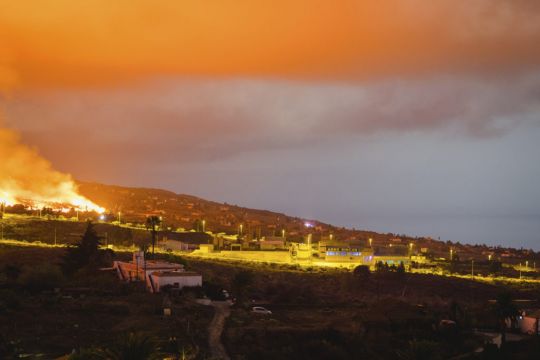Giant rivers of lava are sliding slowly but relentlessly towards the sea after a volcano erupted on a Spanish island, destroying everything in their path while prompt evacuations helped avoid casualties.
The eruption occurred on Sunday on the island of Palma, in the volcanic Canary Islands, along a ridge called Cumbre Vieja, where two fissures belched bright red magma into the air and set the glowing lava rivers in motion.
Scientists had been monitoring the area in recent days amid a surge in small earthquakes, and authorities evacuated around 5,000 people.

The lava was moving at 700 metres (2,300ft) per hour, according to the Canary Islands Volcanology Institute. Officials said they expect it to reach the Atlantic Ocean around sunset.
The lava left black swathes of destruction through the sparsely populated, green countryside and destroyed around 100 houses, officials said.
Authorities told people in areas where volcanic ash was falling to stay indoors with their doors and windows closed.
The lava crept into the town of Los Llanos de Aridane, which lies close to the volcano. Mayor Noelia Garcia said people had been evacuated from houses all the way down to the shoreline.

Mariano Hernandez, head of the island’s government, described the scene in the area affected by the lava as “bleak”.
He said a wall of lava six metres (20ft) high “is consuming houses, infrastructure, crops in its path to the coast”.
Scientists monitoring the lava measured its temperature at more than 1,000C. When it hits the Atlantic Ocean, explosions and clouds of acidic steam are expected, and merchant shipping was halted around La Palma.
Scientists say the lava flows could last for weeks or months, but the immediate danger to local people appears to be over.
Canary Islands government chief Angel Víctor Torres said officials were not expecting any more eruptions, adding that air traffic was not affected.
“There will be considerable material damage,” he told SER radio. “We hope there won’t be any personal injuries.”

No further evacuations are expected, officials said.
The eruption opened two fissures, about 200 metres (650ft) apart. Officials said the lava streams are likely to merge before reaching the sea.
The Military Emergencies Unit was increasing its deployment on La Palma to 180 soldiers and 57 vehicles, backed up with three water-dropping aircraft.
People on La Palma largely live from farming.
Spanish Prime Minister Pedro Sanchez visited the affected area on Monday after cancelling a trip to New York to attend the UN General Assembly.

He praised scientists for monitoring the eruption, saying their work was “fundamental” in avoiding casualties, and promised that his government would help local people rebuild their lives.
The Canary Islands Volcanology Institute reported the initial eruption shortly after 3pm on Sunday near the southern end of the island, which saw its last eruption in 1971.
A 4.2-magnitude quake was recorded before the eruption, which took place in an area known as Cabeza de Vaca on the western slope as the ridge descends to the coast.
Huge red plumes topped with black-and-white smoke shot out along the Cumbre Vieja ridge, which scientists had been monitoring following the accumulation of molten lava below the surface and days of small earthquakes.
La Palma, with a population of 85,000, is one of eight volcanic islands in Spain’s Canary Islands archipelago off Africa’s western coast.
Mr Hernandez asked people to stay away from the area, adding: “We are having serious problems with the evacuation because the roads are jammed with people who are trying to get close enough to see it.”







